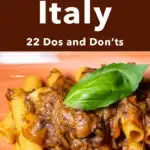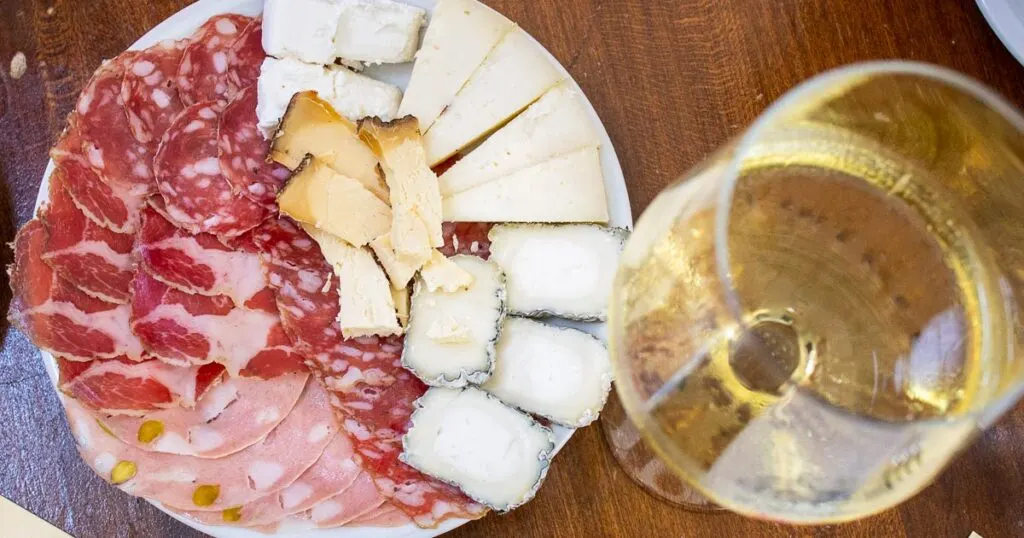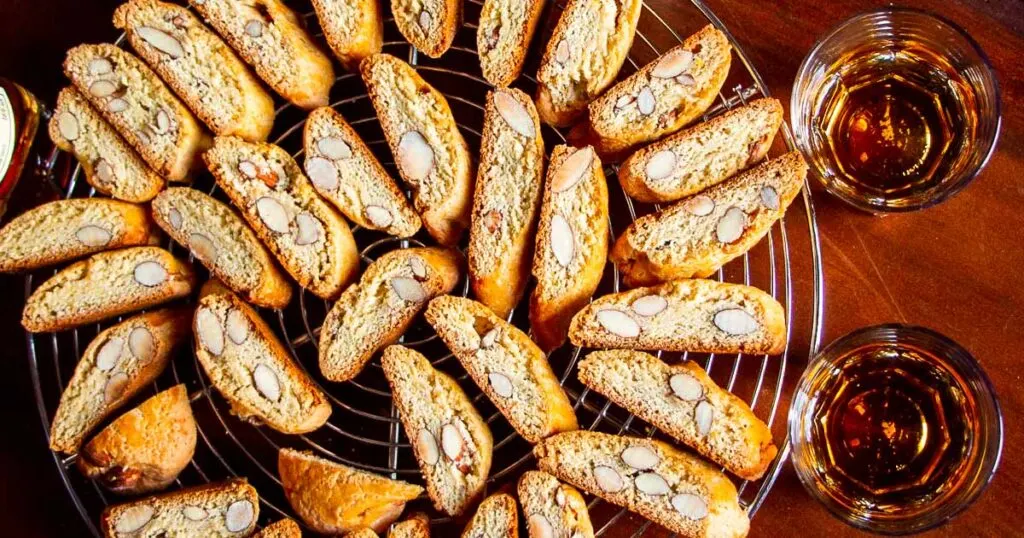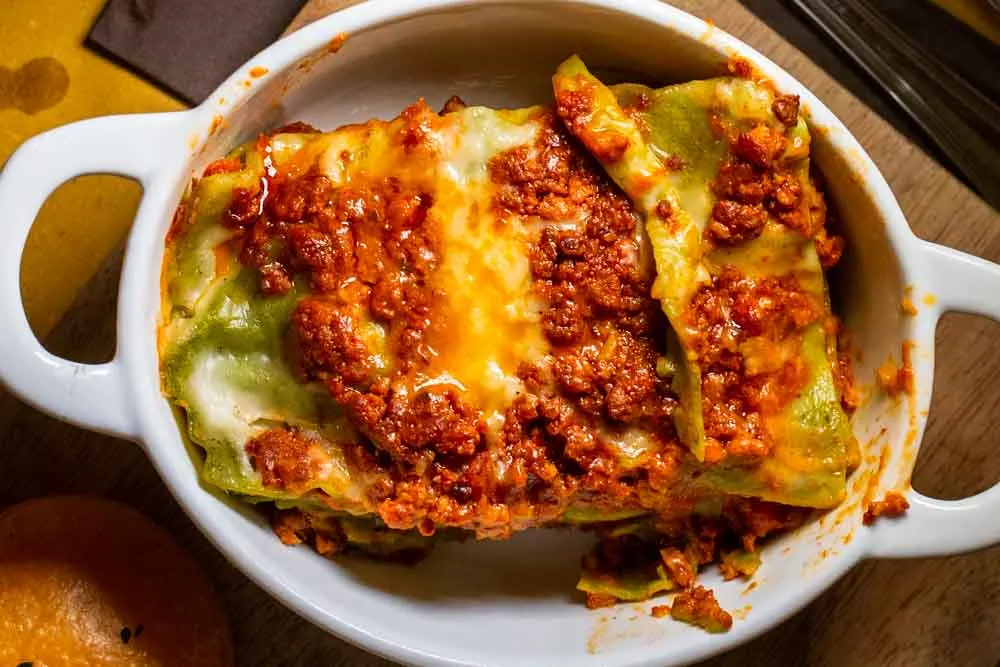We love eating in Italy! Discover 20 tried-and-true Italy travel tips that will enable you to eat Italian food in Italy like a pro instead of a schmo.
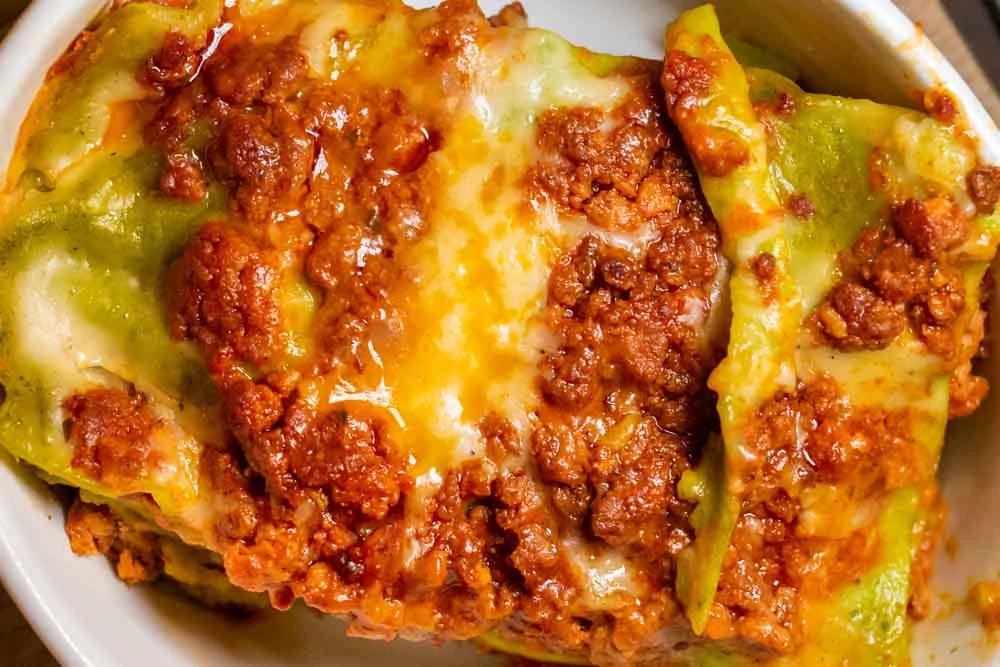
We love eating in Italy.
This love has no boundaries. It extends from Basilicata in the south to Trentino in the north. And it doesn’t just focus on one type of Italian food. This boundless love includes pizza, pasta and lots of fried stuff.
Our only fear when we dine in Italy is that we’ll get too full to eat it all.
However, we understand that others may fear breaking the country’s unwritten dining rules. We felt that way before we visited pizza’s homeland for the first time too. Now that we’ve traveled to Italy more than a dozen times and counting, we’re all good with Italian dining customs.
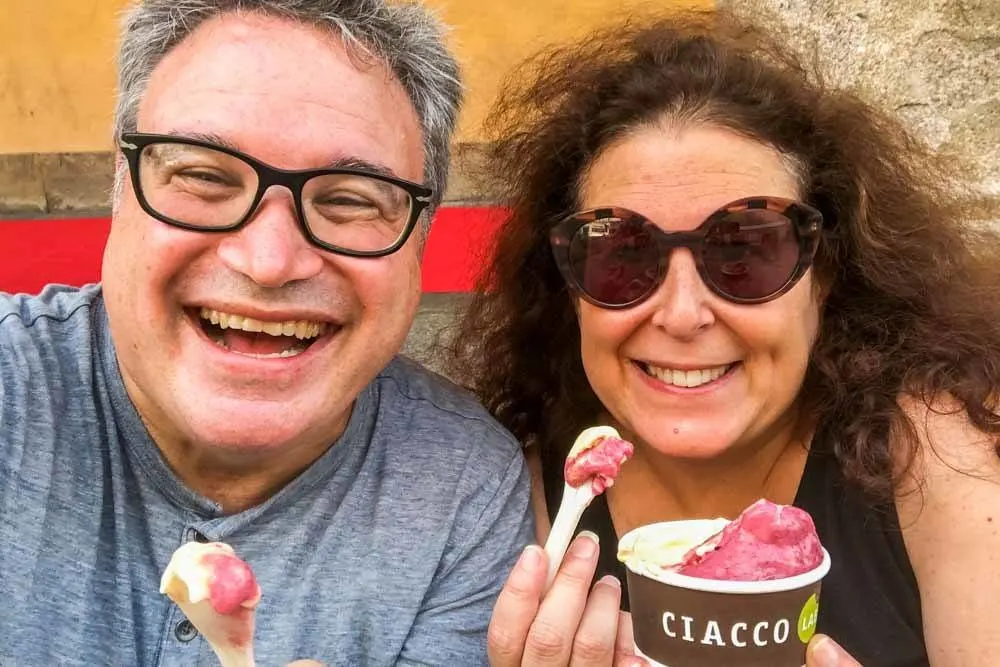
Our main piece of advice is to put that fear in a box and smash it. Italians won’t judge you for being an Italian food dining novice. Okay, they probably will. But does it really matter when their food tastes so great?
While there’s no blame for the shame, we’re here to help you eat like an Italian food pro. As for learning the Italian language, that’s another story.
Eating In Italy – 12 Do’s
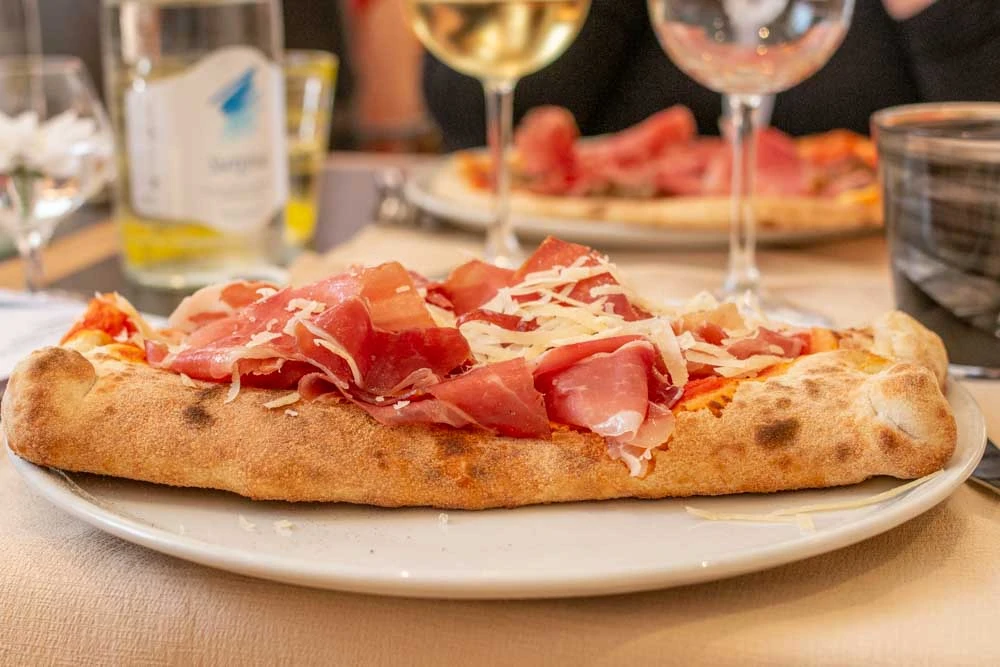
Buckle up! Now that you’ve decided to travel to Italy, you’re practically guaranteed a culinary journey that will ruin your appreciation for food in most other countries.
Don’t get us wrong. We love the food in our home country of America, our adopted country of Portugal and culinary giants like France and Japan. However, there’s something special drinking wine in a Venetian cicchetti bar and eating gelato in Bologna that can’t be replicated elsewhere.
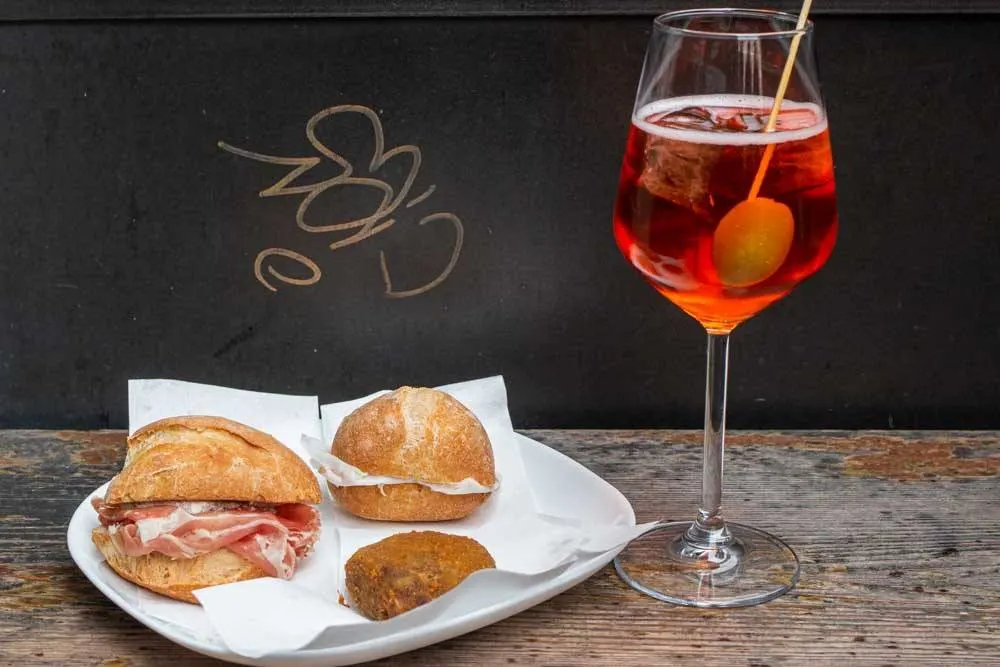
As much as we love dining in Italy, we realized that doing so can be a challenge to first-time visitors. In fact, when we met an American couple during a train trip from Bologna to Florence, they confided they had enjoyed their Italian tour but had trouble navigating the country’s food scene.
Oh how we wish that we had met them just two weeks earlier so that we could have given them the following Italy travel tips!
1. Eat Local By Region
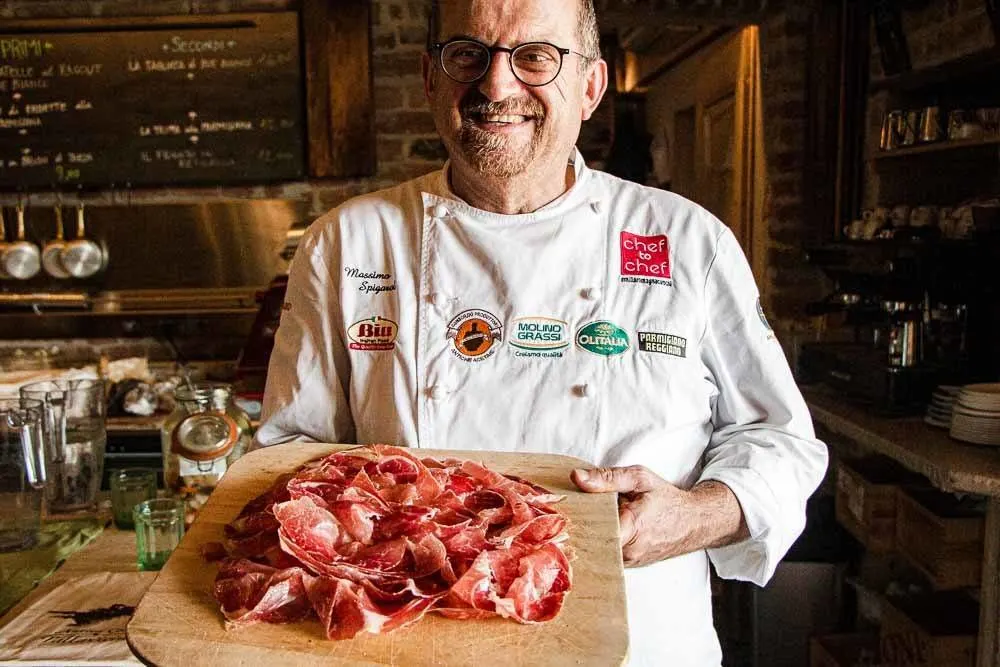
Italy has 20 distinct regions that date back to the days before the Kingdom of Italy became a country. Many of these regions, like Campania and Tuscany, are famous around the world while others live under the radar. Not only does each region have its own customs and histories, but they all have distinctly unique food cultures.
While it’s it’s human nature to want to eat pizza in Italy regardless of the region, the better move is to quickly research each region’s top food before you arrive. You’ll then be practically guaranteed a memorable dining experience whether you eat pesto in Liguria or orecchiette in Puglia.
Disclosure
We won’t judge you if you can’t resist ordering pizza. We eat pizza in every Italian region ourselves but only after we sample local specialties first.
2. Shop At Local Food Markets
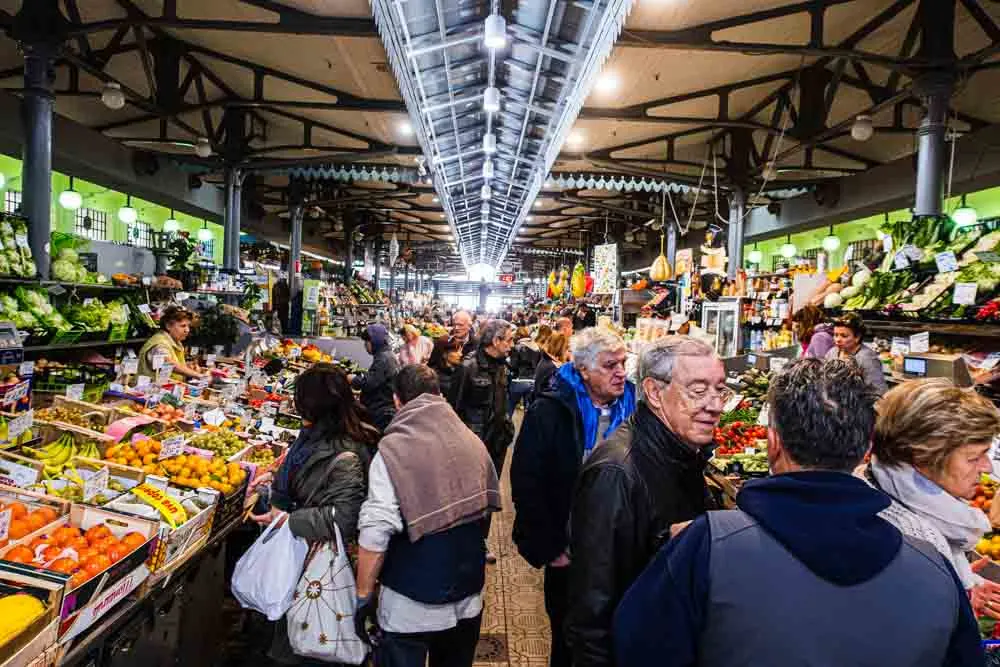
Food markets are a key element of Italy’s food scene.
Most Italian cities have one major market with more sprinkled around the neighborhoods. This is where locals shop for vine-ripened tomatoes and freshly caught fish. It’s also where intrepid food travelers can learn a lot about a city’s local food products while nibbling on tasty tidbits.
Our favorite Italian markets include Mercato delle Erbe in Bologna, Mercato di Sant’Ambrogio in Florence, Mercato Albinelli in Modena, Mercato Testaccio in Rome and Mercati di Rialto in Venice. We’ve also heard great things about A’Piscaria in Catania and Piazza delle Erbe in Padua.
Buy an Italian-themed canvas bag from Amazon to carry all of your Italian market purchases.
3. Eat Pizza With Utensils… Usually
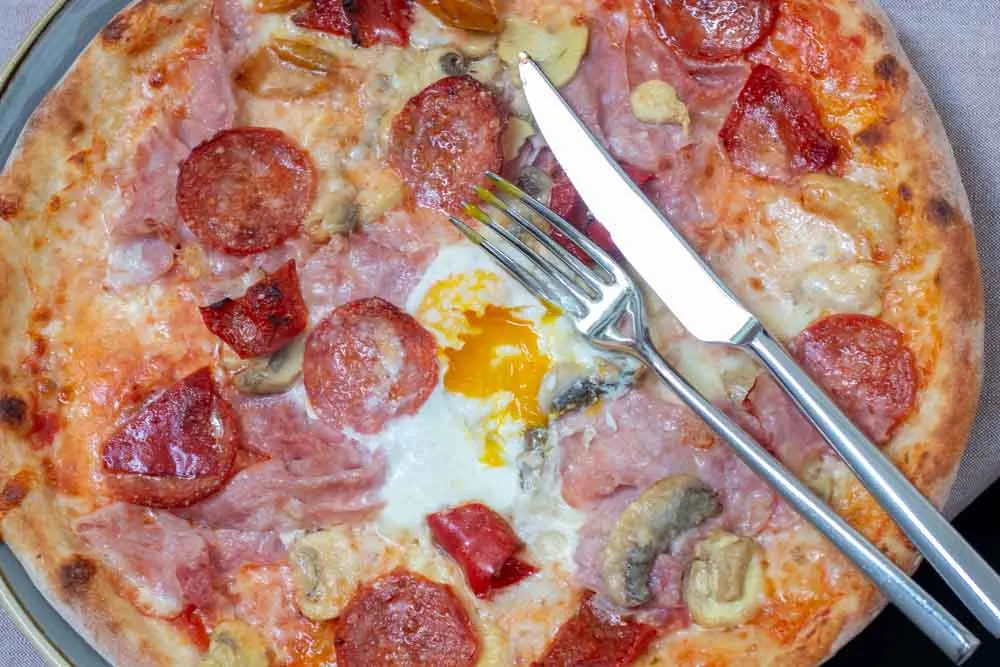
If you visit Italy without eating pizza, did you really visit Italy? We’re kidding, sort of. That’s how prevalent pizza is in Italy. But not just one kind of pizza.
Hailing from Naples, Neapolitan Pizza is always served as individual whole pies with the diner usually responsible for cutting it into slices. While locals use a knife and fork to eat this type of pizza, we like to eat our pies with a hybrid method that involves folding each slice after we cut it with our utensils. We honed this skill after years of eating pizza in cities like Philadelphia, New York, Rome and Verona as well as in Campania.
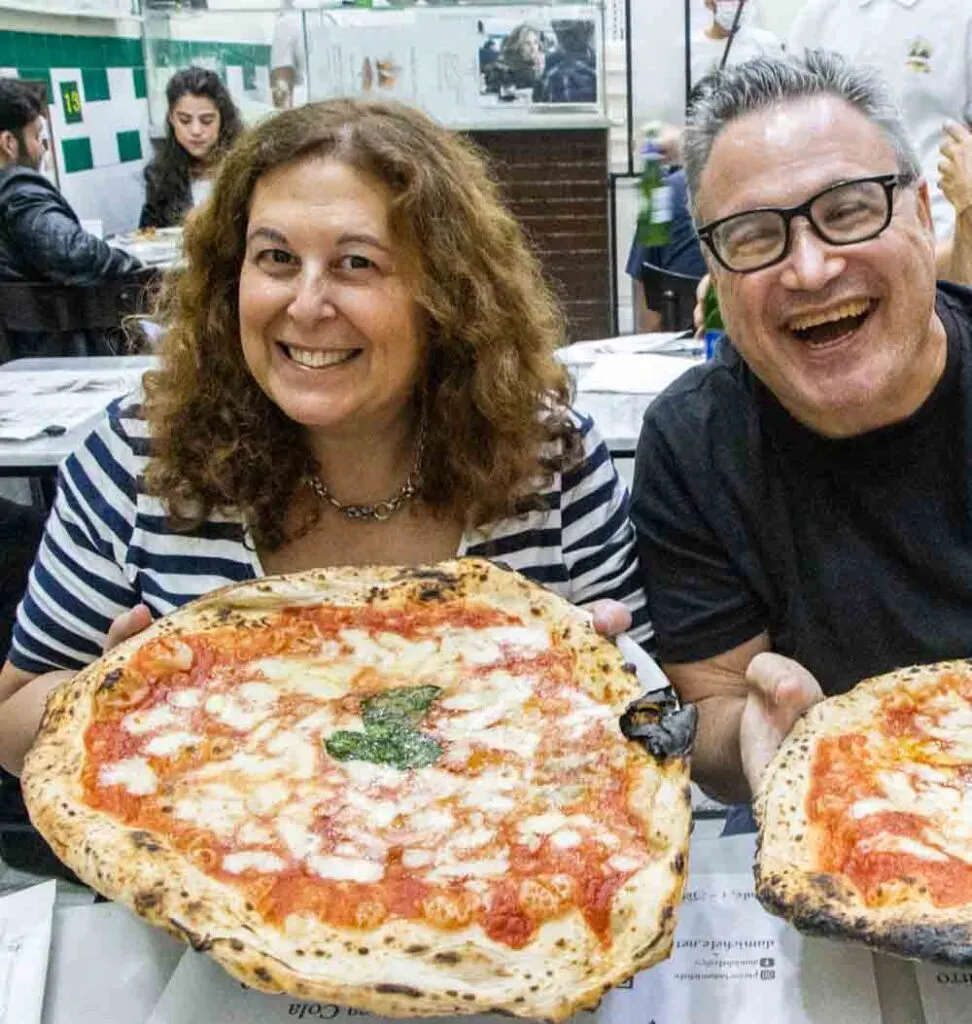
Rome has two main styles of pizza – Pizza al Taglio, which is typically cut into slices and sold by weight, and thin crust round pies called Pizza Romano. Further south, the Mediterranean island of Sicily specializes in Pizza Siciliana which can be rectangular and/or stuffed except when it isn’t. Then there’s fried pizza called Pizza Fritta, another Neapolitan specialty.
Pro Tip
Observe how the locals are eating their pizza whether you’re in Lazio or Abruzzo and follow their lead. You can then chow down with confidence and eat what will hopefully be the best pizza of your life.
4. Make Advance Restaurant Reservations
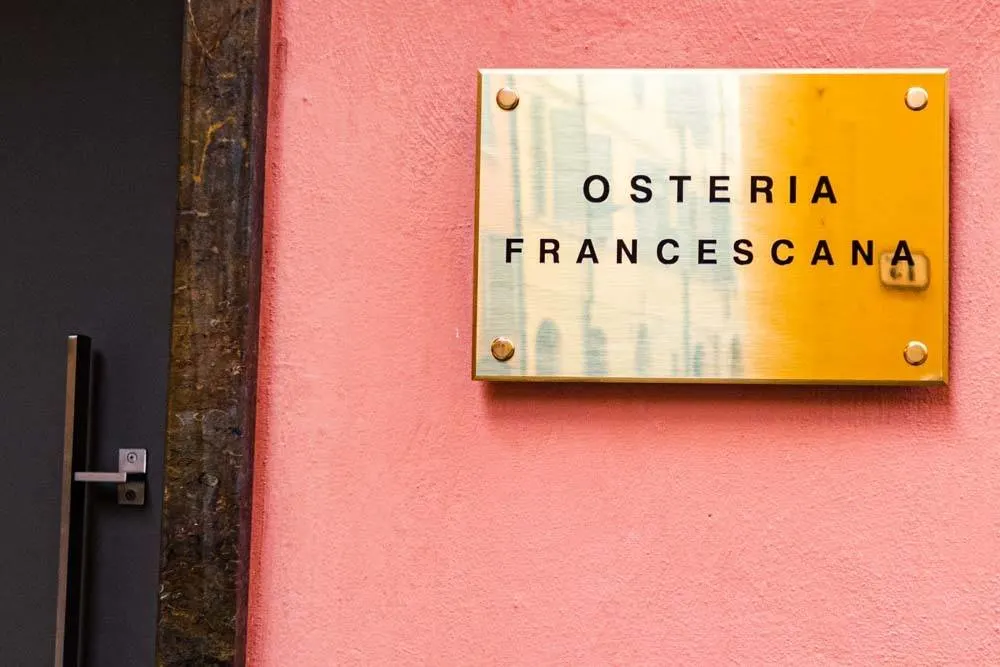
We’ve noticed an epidemic among American travelers and it’s one that especially afflicts families. It creates stress during holiday vacations and causes major disruptions involving disagreements, panic and, ultimately, desperation. For food travelers, it can turn a trip to the Italian paradise into an Italian nightmare.
And the worst part? This sickness is neither necessary nor contagious. The cure is as simple as making advance restaurant reservations.
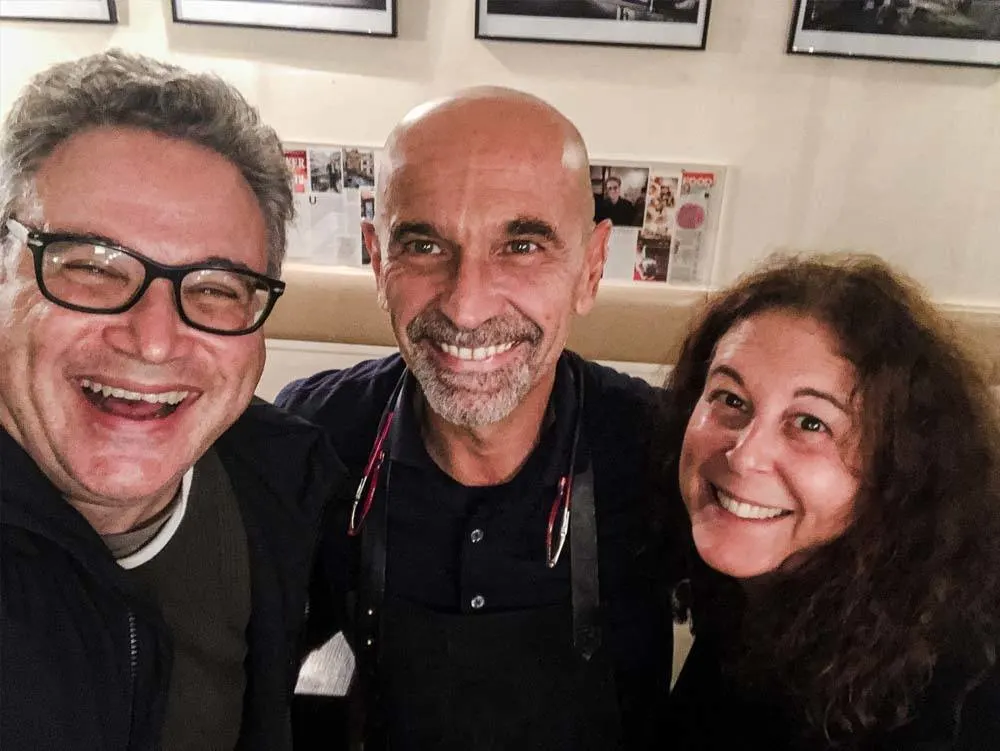
If you wander around any Italian city, particularly during high tourist season, and pass a plethora of restaurants with touts at the doors and menus translated into 10 different languages including Chinese, you have to wonder “who eats there?” Well, we’ll tell you who – people who really don’t care about food or… those who fail to plan in advance!
You don’t have to make reservations super far ahead for most restaurants in Italy. In some cases, you can walk into a popular local restaurant a couple days before your planned meal, have a pleasant conversation with the host and walk away with a reservation. It’s so simple yet so important to do.
Pro Tip
Start planning at least a month in advance for the most popular restaurants. Some offer electronic reservations while others require a phone call. So, when you make your hotel reservations, start reserving your meals too. If you do, your chances of a bad meal in Italy are practically nil.
5. Drink Your Morning Coffee While Standing At The Bar
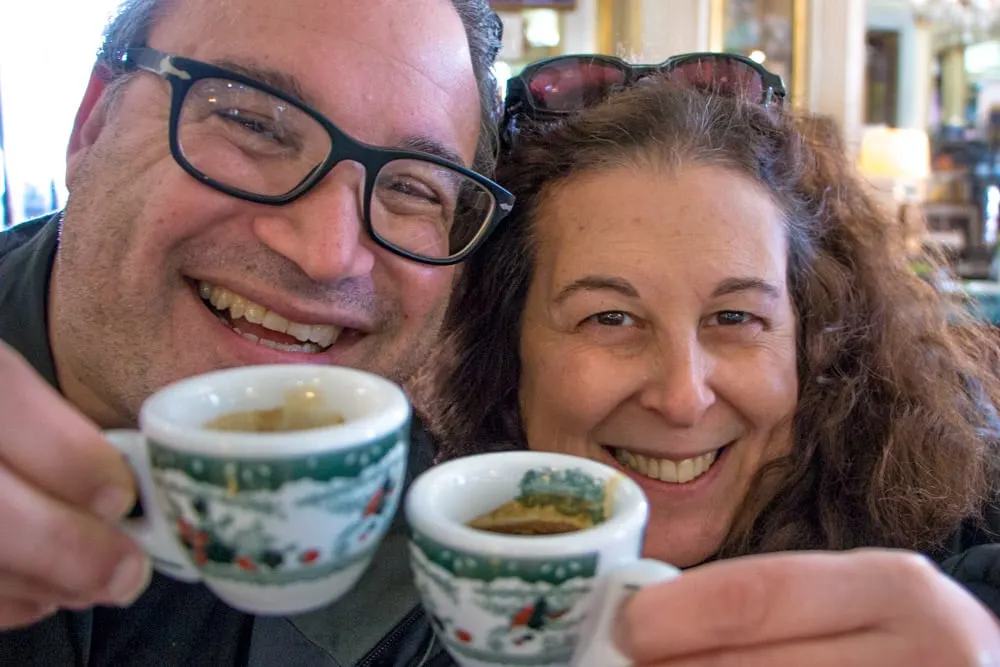
We drank a lot of coffee while living in Naples for a month back in 2017. Not familiar with Italian coffee protocol when we arrived, we quickly learned to order and drink our morning coffee the same way at every bar in town.
Based on our on-the-ground research, this is our recommended way of ordering coffee in Italy without getting the dreaded eye roll:
Pro Tip
Order a cappuccino, caffè latte or macchiato instead of a caffè if you like milk in your coffee. Don’t request a latte or you may end up with a cup of milk.
6. Eat A Big Lunch
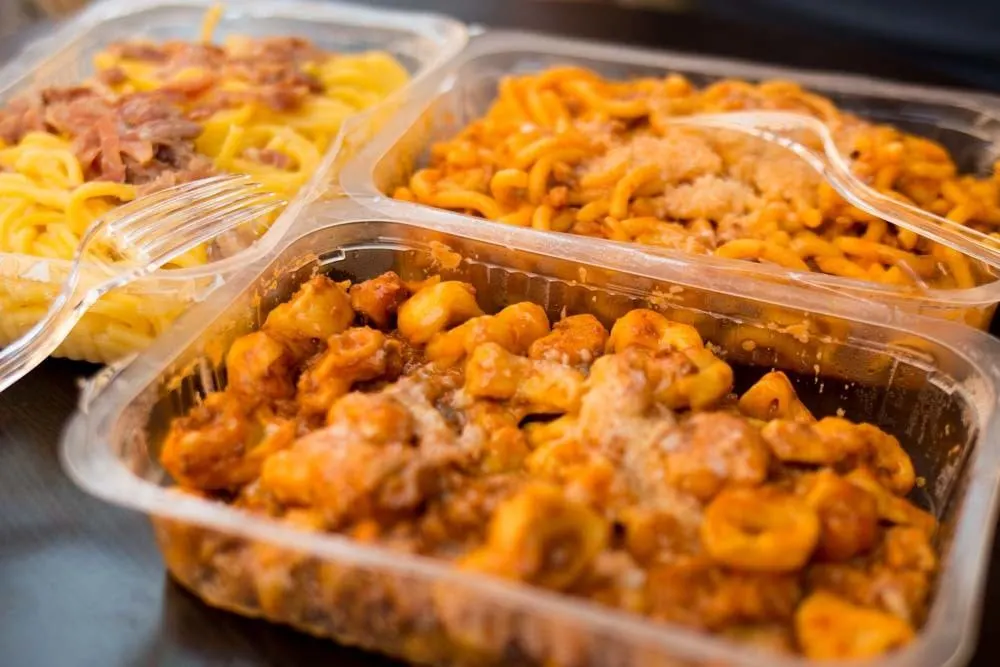
The adage that breakfast is the most important meal of the day doesn’t apply in Italy where most breakfasts pair coffee with a cornetto or other pastry. This is a country where the real food action occurs during lunch.
Unlike Americans who sprint through lunch, Italians often linger over their midday meals, eating multiple courses, sipping wine and ending on a sweet note. When you eat lunch in Italy, budget adequate time and consider ordering the following:
Pro Tip
Don’t worry if time is of the essence. A quick Italian lunch option is to eat a panino (sandwich) filled with local salumi (cured meat) and formaggio (cheese). In our opinion, Italy’s panino is one of the best sandwiches in the world.
7. Get Creative With Balsamic Vinegar
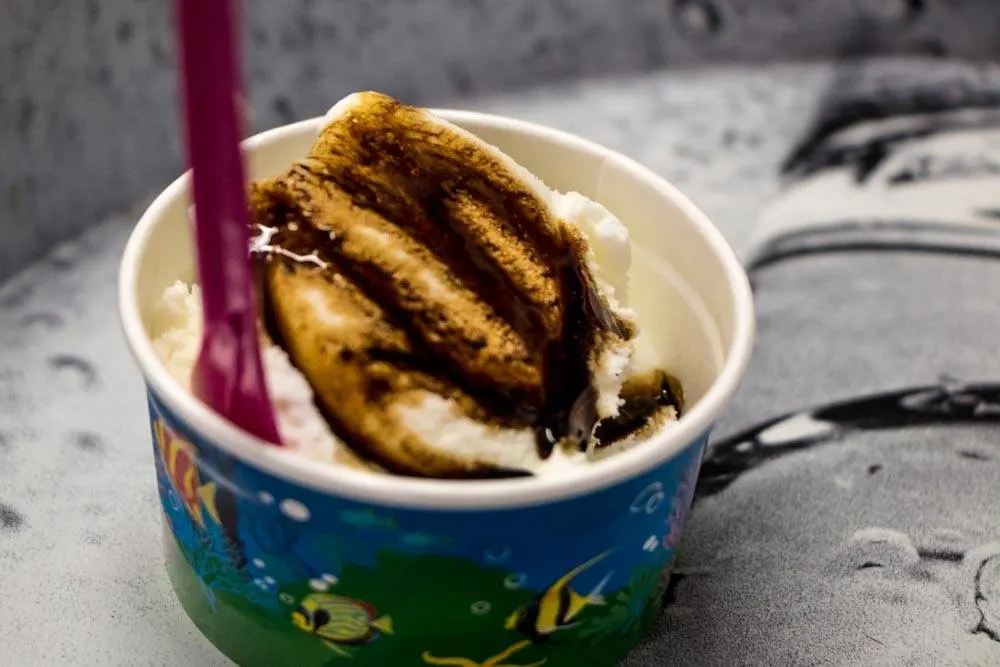
If you think that you know traditional balsamic vinegar based on the balsamic vinegar that you’ve purchased at the grocery store – think again. Artisan balsamic vinegar is a Denominazione di Origine Protetta (DOP) product that can only be produced in Emilia-Romagna. And, unlike the grocery store version made with vinegar, sugar and additives, traditional balsamic vinegar has just one ingredient – grape juice.
Balsamic vinegar producers age that grape juice for at least a decade but preferably for more than a quarter century. The fermentation and maturation process may take years of patience but the end result it a luxury product that’s a worthy splurge.
Pro Tip
Balsamic vinegar is a superb ice cream topper. If you don’t believe that ice cream and traditional balsamic vinegar are a match made in heaven – add a few drops and taste it for yourself. You can thank us later.
8. Pre-Game Dinner With Aperitivo
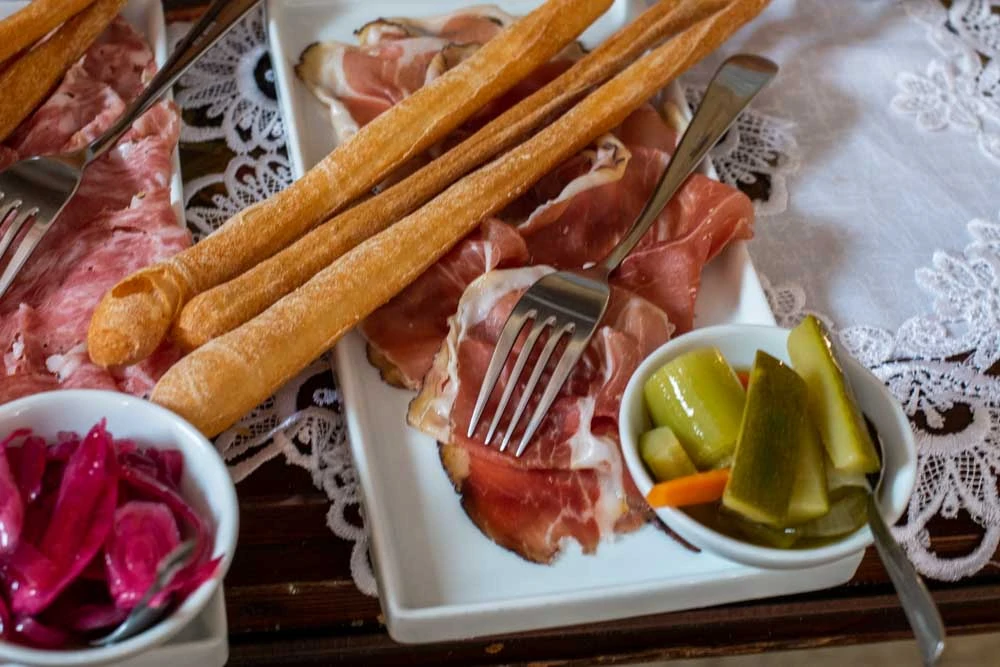
If it’s 5pm in Italy and you find yourself walking around Bologna’s Quadrilatero, through Naples’ Piazza Bellini or in Rome’s Piazza Benedetto Cairoli, you’ll notice tables filled with ‘pre-gamers’ holding bright orange Aperol Spritzes in their hands. Most likely, they’re also munching on a range of appetizers – from nuts and olives all the way to platters filled with a large assortment of salumi and cheeses.
In other words, it’s aperitivo time in Italy.
More than just a ramped up version of the American ‘happy hour’ or a chance to guzzle Italian cocktails, Italy’s aperitivo is a time to connect with friends as the sun goes down while enjoying special meats like culatello in Parma and porchetta in Rome as well as great local cheeses like Modena’s aged parmigiano-reggiano, Florence’s sheepy Pecorino Toscano and Napoli’s fresh, creamy slightly tangy balls of mozzarella di bufala. If you’re so inclined, it’s entirely possible to turn an aperitivo session into an early dinner.
Fun Fact
Novices order spritzes and proseccos while the more experienced among us opt for a negroni or glass of wine. Some of the best Italian bars go so far as to omit spritzes from their menus.
9. Order Wine At Every Meal
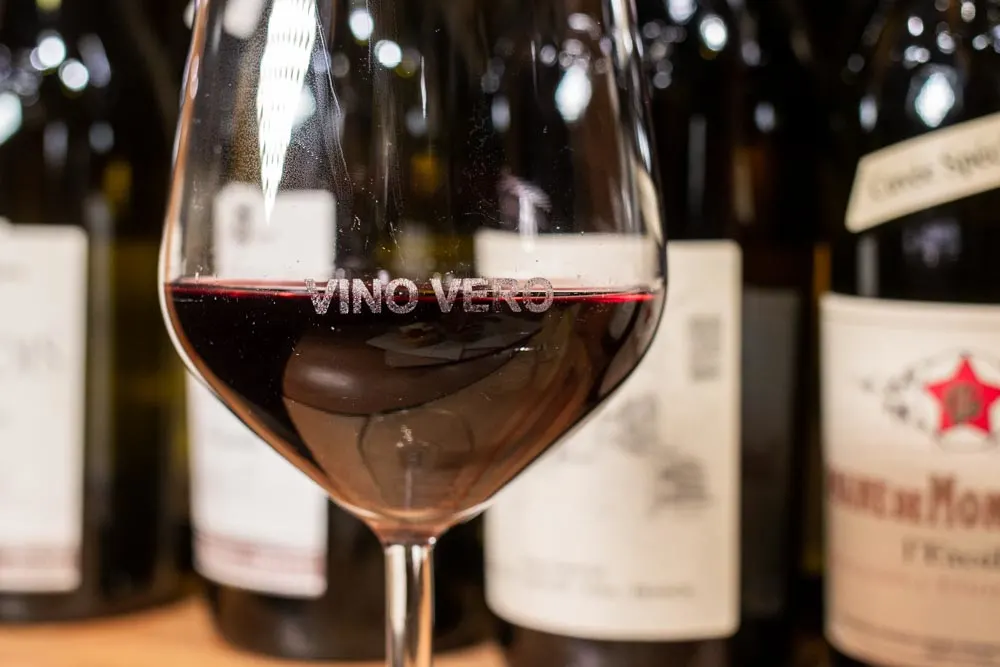
We exaggerate when we say to order wine with every meal since we don’t usually drink wine in the morning. However, we stand by this recommendation when it comes to drinking wine every time you eat lunch and dinner in Italy.
This tip may seem excessive. However, unlike in America, you don’t need to worry about breaking the bank or becoming intoxicated when you order wine at most Italian restaurants. Many offer a vino della casa (house wine) that’s both local and inexpensive with options to order by the glass or carafe in addition to by the bottle.
Pro Tip
Pizza is an exception to this tip. It’s a well known fact that pizza pairs equally well with beer as it does with wine. Italy now has a number of breweries throughout the country and you can’t go wrong with ordering a pint of craft Italian beer to go with your pie.
10. Eat Pasta As A First Course
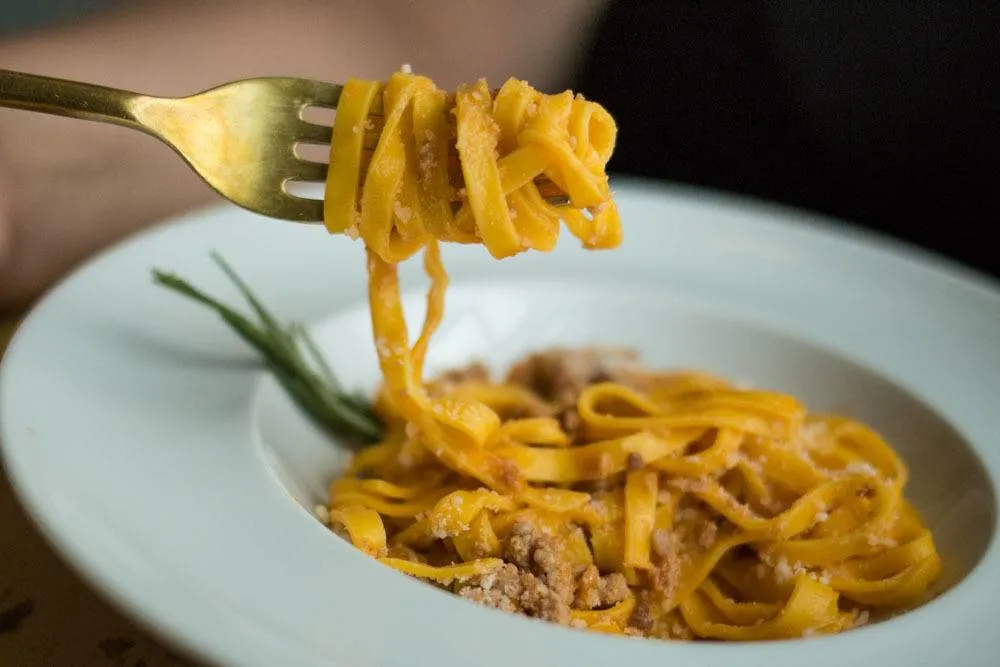
Finding pasta in Italy is super easy once you know where to look.
Some markets fill shelves with the stuff while others have entire back rooms packed with boxes of dry pasta. Nonnas (Italian grandmothers) make pasta by hand, using pasta-making skills that look so easy but, as we’ve experienced during Italian pasta classes, require a special touch passed through the generations.
At restaurants, the primi section is the place to look for pasta on an Italian menu. Primi translates to ‘first courses’ which is the time of the meal when Italians eat a small-ish serving of pasta unless they’re in the mood for risotto or soup.
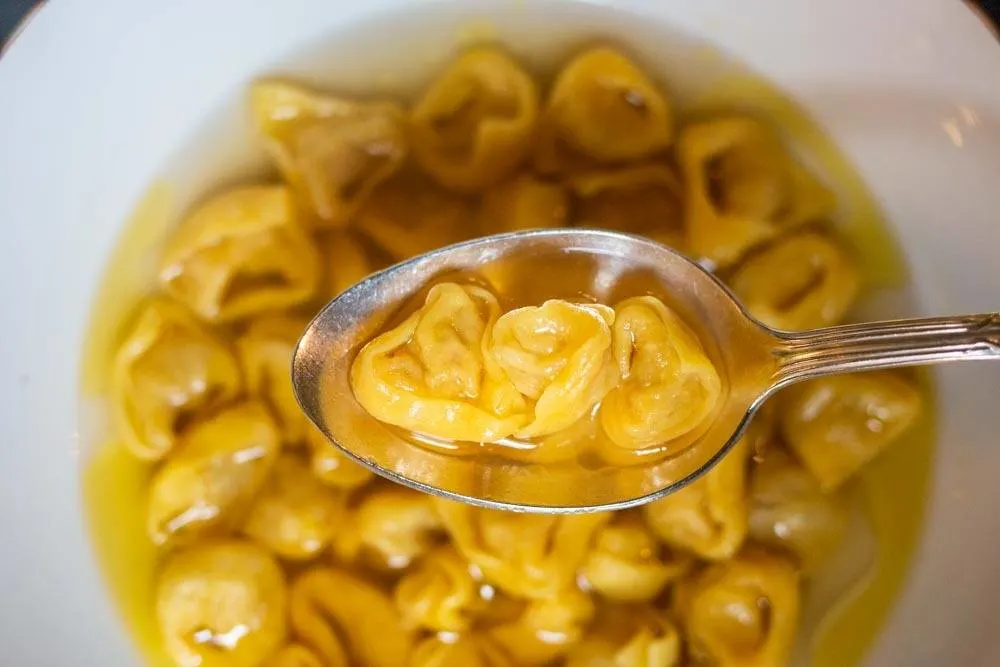
You can and should order a pasta primo (first course) followed by a secondo (main course). However, if you’re not super hungry, don’t be embarrassed to skip the secondo or share one or both courses with a friend. Then again, the better option may be to abstain from eating the bread.
Pro Tip
Eat classic Italian pasta at home if you don’t have any upcoming trips planned for Italy. As a shameless plug, we recommend our Amatriciana, Bottarga, Carbonara, Gricia, Cacio e Pepe, Genovese and Puttanesca pasta recipes
11. End Your Meal With An Espresso Or Digestif
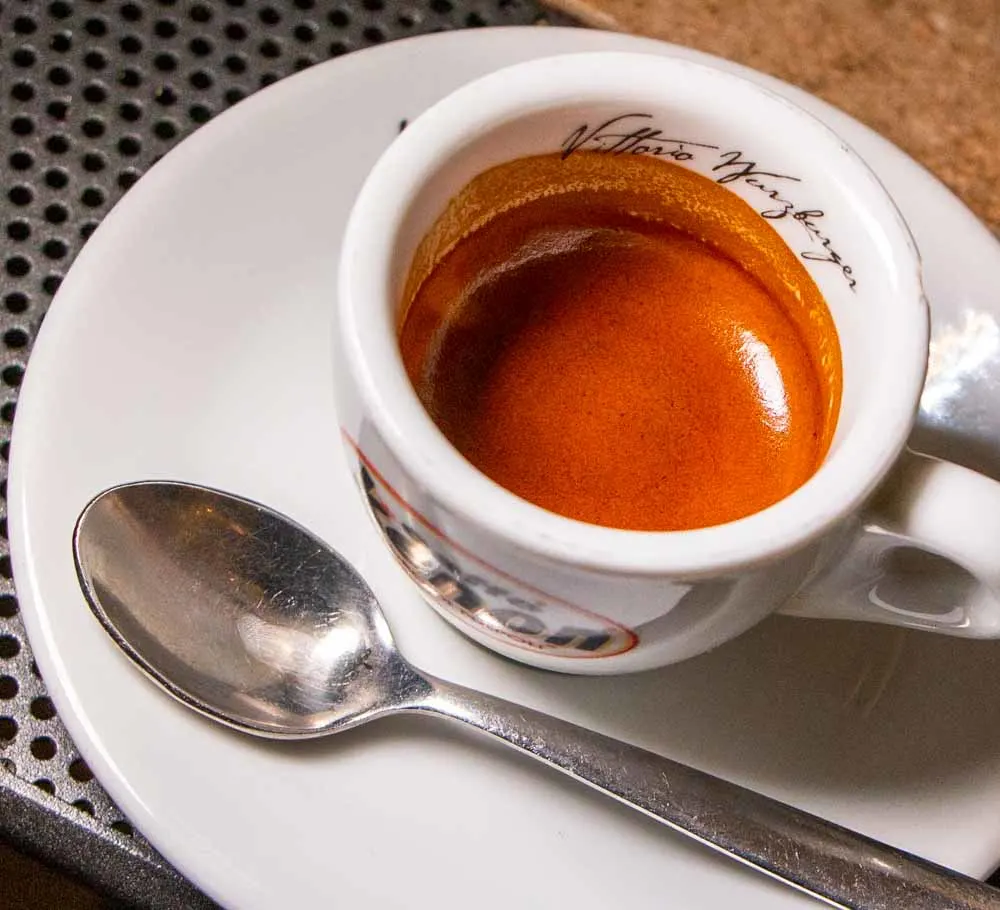
While Americans consider it counter-intuitive to drink coffee at night, Italians choose to embrace coffee’s digestive benefits at all hours. Accordingly, it’s not uncommon for Italians to drink a caffè after dinner even if their dinner ends close to midnight.
Perhaps the real reason is to extend the social aspect of the meal for just a little bit longer. Either way, the bonus cup provides a nice bookend to the cup that started the day.
Pro Tip
Order an Italian digestif like Amaro, Limoncello or Grappa if you want to end your night without caffeine.
12. Save Room For Gelato

Eating one gelato cone is a must for all ice cream fans who travel to Italy. And by one gelato cone, we mean one gelato cone every day. However, we’ll understand if one isn’t enough.
To be clear, Italians didn’t invent ice cream. However, they made the frozen dessert better when they started crafting it with less fat, less air and in flavors like pistachio and stracciatella.
Pro Tip
Make a point to eat gelato in every Italian city that you visit. Get started with our gelato guides for Bologna, Naples, Rome, Venice and Verona.
Eating In Italy – 8 Don’t’s
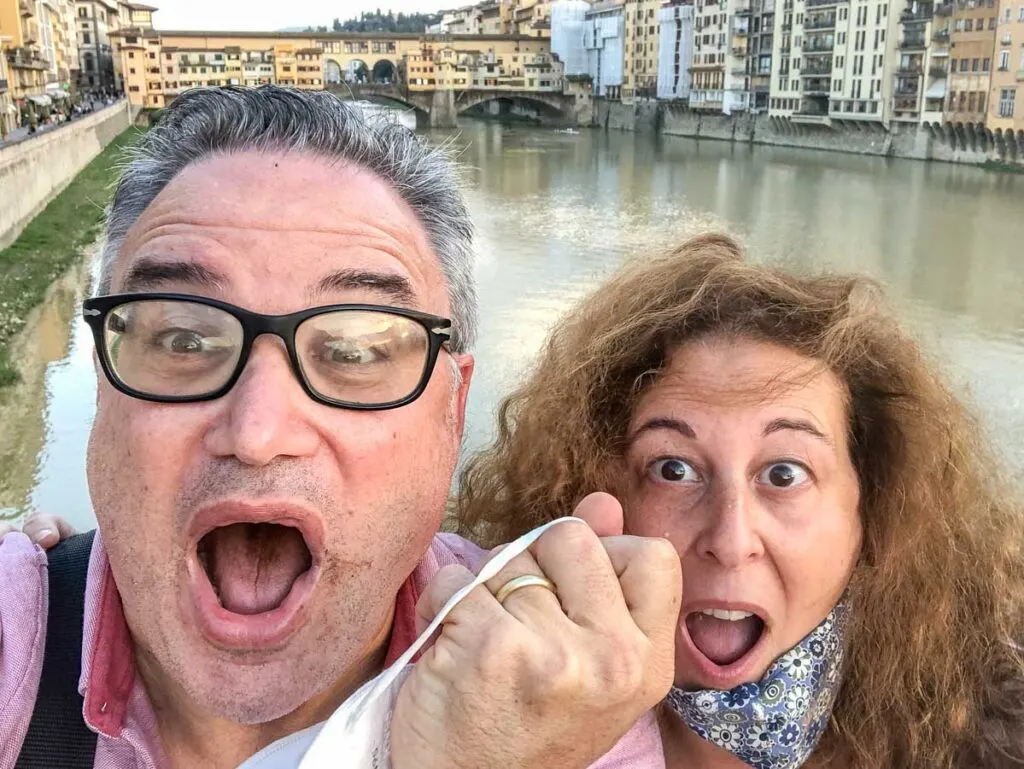
Now that we’ve shared a dozen things that you want to do when you eat in Italy, it’s time to share almost as many things that you don’t want to do when you mangia (eat in Italian) in cities like Rome and Venice. After all, respecting Italian food culture is part of the fun of eating in Italy.
Read on for some of our best tips, including one that involves not leaving tips:
1. Don’t Feel Compelled To Leave A Tip
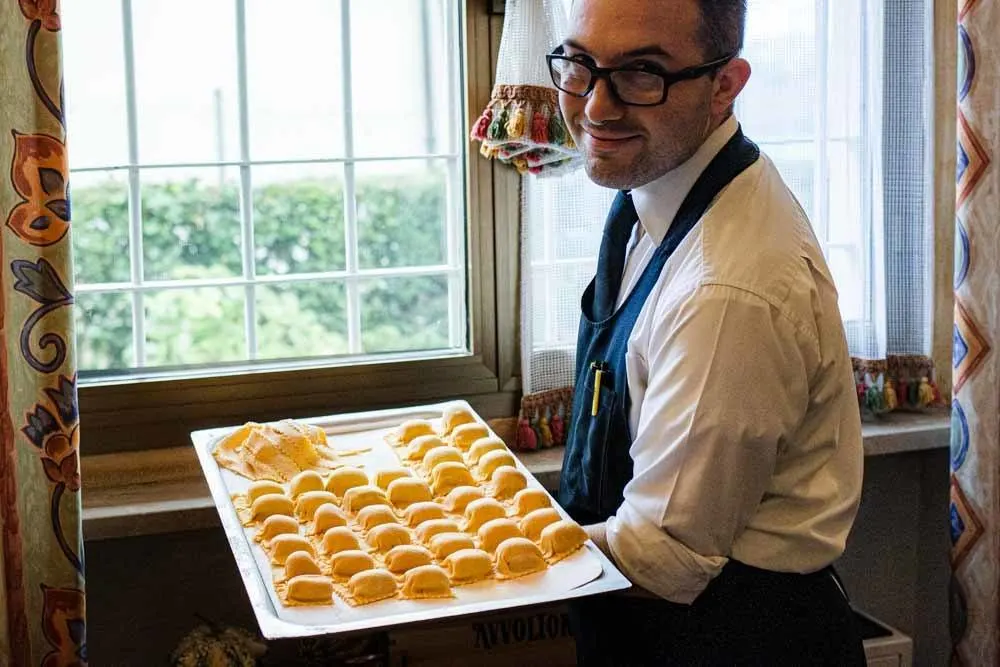
One of the things we love best about living in Portugal is that most European restaurant employees are paid a living wage and aren’t reliant on tips to pay their rent. The pain is real when we return to America and feel obligated to leave 20% service for adequate service.
In Italy, like much of Europe, both tax and service are typically included in restaurant bills. Some Italian restaurants charge a small fee called a coperto to cover the cost of bread and condiments but these fees are always listed on the menu and shouldn’t be a surprise.
Like the rest of the world, Italian servers appreciate a little something extra in recognition of excellent service. We typically round up the bill to the nearest 5 or 0 when we eat out in Italy.
Be aware when the occasional server tries to take advantage of your ‘Americaness’ by saying that “service is not included.” It’s a cheap line that’s been passed from server to server for generations all over the continent and should be ignored.
Pro Tip
Make your barista happy by leaving a small gratuity after you finish your morning coffee jolt. We’re talking about 5 to 10 centimes. After all, caffés rarely cost more than a euro in Italy.
2. Don’t Order A Cappuccino After 10am… Unless You Really Want One
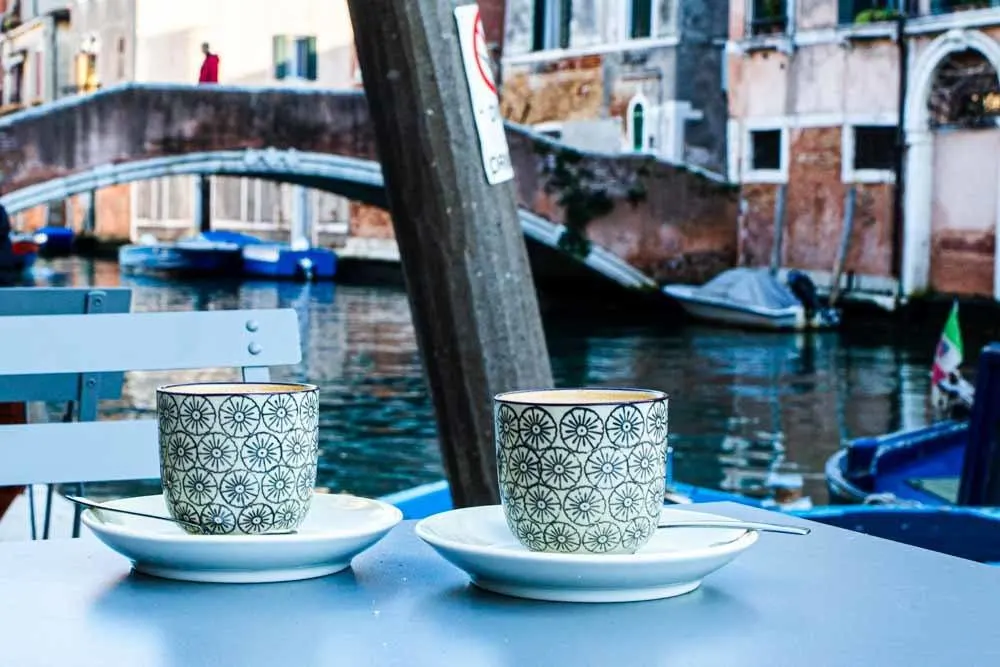
Contrary to popular wisdom, you can order a cappuccino after 10 am at an Italian cafe. Baristas will make you a cappuccino at any time of day even though Italians tend to drink milky drinks in the morning only. Be warned, however, that you may get a funny look.
The better option may be to find a coffee shop that specializes in serving cappuccinos, flat whites and pour overs all day long. Though not as common as in other European countries, specialty coffee shops are no longer unicorns in Italy.
We discovered enough specialty coffee shops in Florence and Rome to write coffee guides for both cities. We even found one in Naples, a relatively recent development that both surprised and delighted our coffee-loving souls. However, don’t expect to find non-traditional coffee shops in smaller towns and villages.
Pro Tip
Order a caffè corretto if you want to drink your coffee with a little something extra, i.e. a shot of brandy, grappa or sambuca.
3. Don’t Snack Between Meals
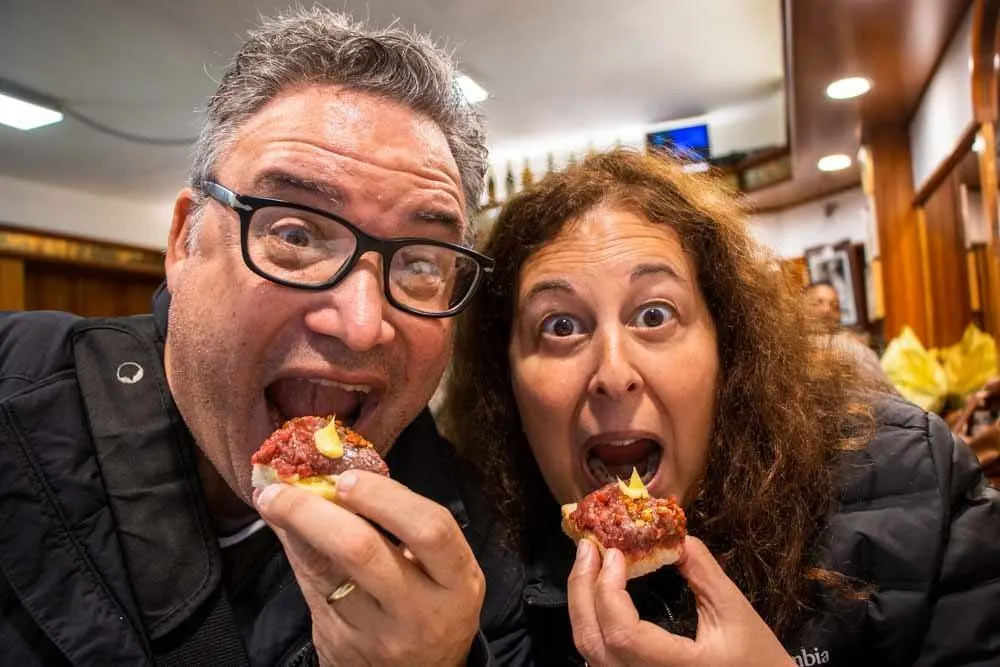
The temptation to snack in Italy is real.
Cities like Naples and Palermo are filled with magical shops called friggitorie that sell fried treats like arancini and fritatine. Then there are bakeries called pasticcerie that sell an endless selection of Italian sweet treats like Cannoli, Sfogliatella and Bombolini. And that’s not even counting the gajillion gelato shops called gelaterias.
Our best advice is to be as strong as possible. Your reward will involve aperitivo plates topped with salumi and cheese plus glasses filled with wine, beer and spritzes.
Pro Tip
Ordering gelato in a coppa (cup) instead of a cono (cone) is a justifiable compromise if you need an afternoon pick-me-up and don’t want to ruin your appetite for dinner.
4. Don’t Eat Dinner Too Early
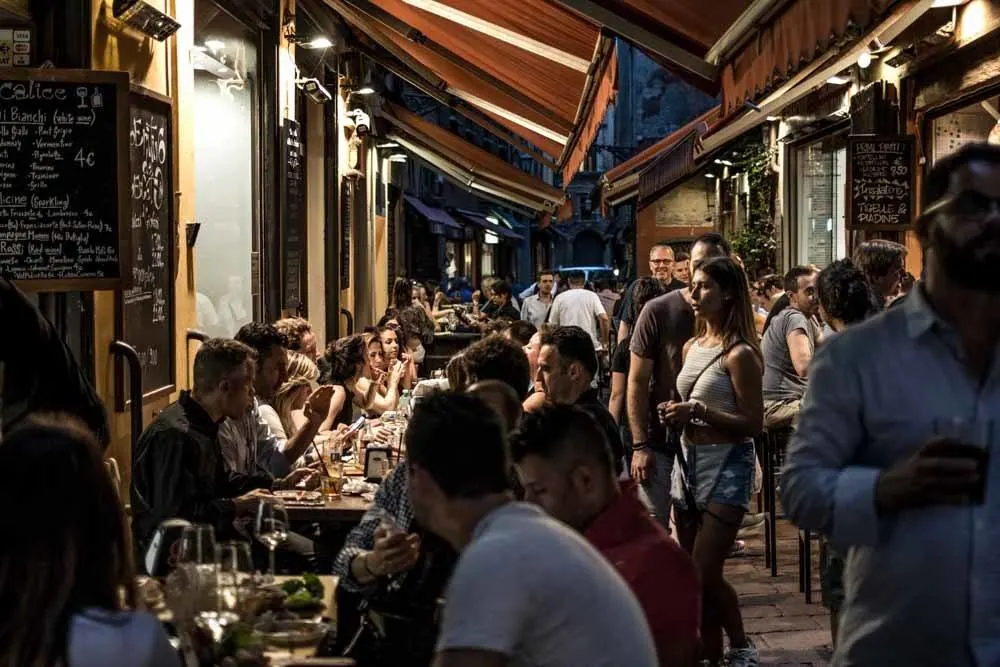
Unlike in American states like Florida, where early bird dinners are popular among the older crowd, Italians of all ages laugh at the idea of eating dinner before the sun sets. Actually, they’re too busy sipping wine to even think about breaking bread before 8pm.
Food travelers who want to experience Italy’s culinary scene like locals will want to follow suit and eat dinner at 8pm or even later. This approach shouldn’t be a problem if you’ve followed our previous tips regarding making advance reservations, eating a big lunch and pre-gaming dinner with aperitivo.
Pro Tip
Italian servers won’t rush you out the door when you’ve taken your final bite. Simply say “Il conto per favore” when you’re ready to pay the bill. However, don’t be alarmed if the server take his or her time to bring it to you. It’s all part of living la dolce vita a/k/a the sweet life.
5. Don’t Order Tap Water

It’s not that Italy doesn’t have potable water. Any visit to Trentino or Lake Garda will prove otherwise. But, for some reason, most Italians don’t drink tap water at restaurants.
On the upside, bottled water is relatively inexpensive in Italy. Plus, it pairs well with wine.
Pro Tip
Order a bottle of water, either still or sparkling, when you dine at restaurants in Italy. Choose frizzante if you’re partial to fizzy water, leggiermente if you’re looking for barely fizzy water or naturale if you prefer flat water. We typically order frizzante since sparkling water is our jam.
6. Don’t Expect To Eat American-Style Italian Food
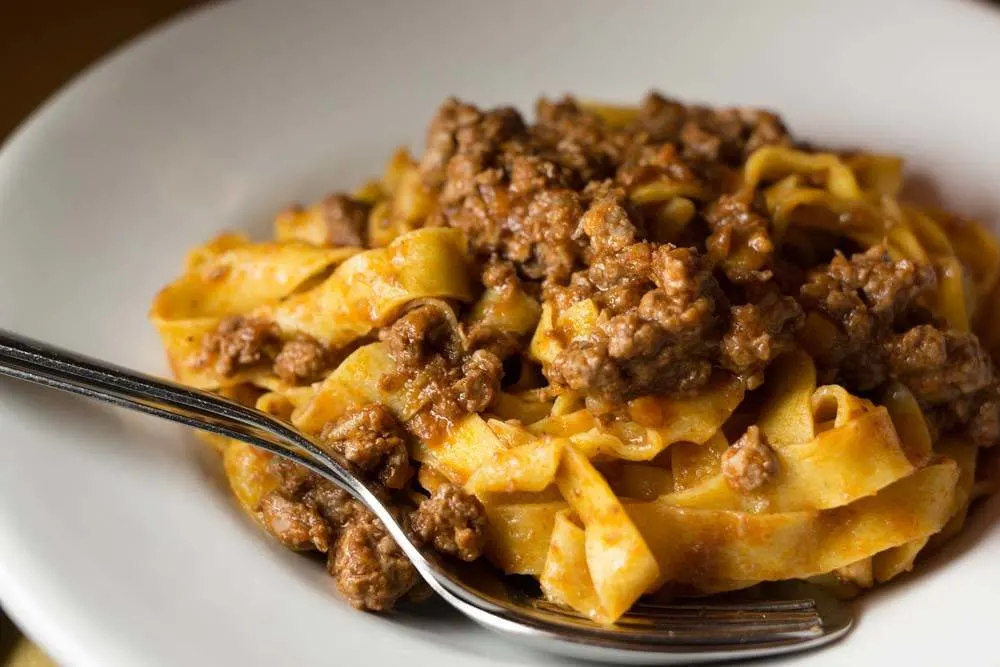
We hate to ‘talk down’ to our fabulous readers but, just in case anybody missed the memo… You probably won’t find Spaghetti and Meatballs when you visit Italy.
Yes, you’ll find meatballs and spaghetti in Napoli (sold separately), lasagna in Bologna and pesto in Liguria. But, although Italian American food and indigenous Italian food share the same roots, they represent separate yet equal styles of cuisine.
While American-Italian food celebrates things like big flavors and abundance, Italy’s cuisine pays homage to the country’s tradition and ingredients. Both Americans and Italians have something to teach each other and, when they do, great food is born.
This cross-pollination dates all the way back to Thomas Jefferson and his chef, James Hemmings, who learned about pasta while traveling in Italy. It was later perpetuated during the great Italian immigration wave when Italian immigrants introduced Italian food to cities like New Orleans and New York.
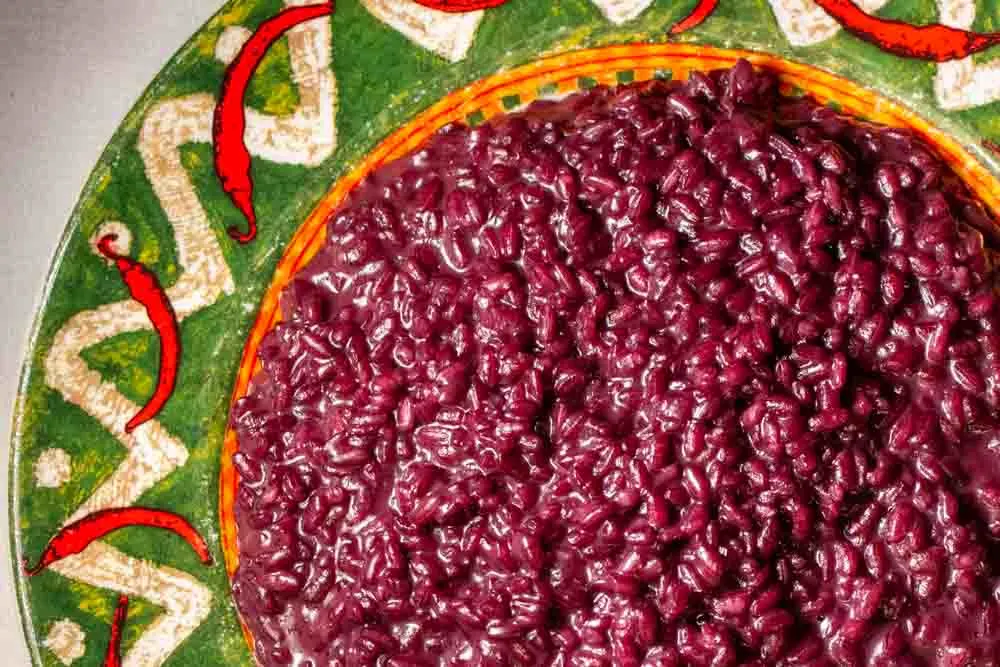
Today’s Italy serves a kind of food that’s both varied and unique in style and flavor.
In Naples, you’ll find pizza eaten with a knife and fork, covered in fresh Mozzarella di Bufala and topped with tomatoes literally grown on nearby Mount Vesuvius. In Bologna, you’ll find ribbons of tagliatella cut and rolled by hand and mixed with a deep flavored meat ragu. And, in Verona, you’ll find risotto made with crimson red Amarone wine that transports something as simple as rice to a level of richness and luxury associated with royalty.
Pro Tip
Take time to appreciate Italy’s culinary history in every bite. The nation is defined by many of its former kingdoms with much of its history reflected in the food.
7. Don’t Order Every Course Unless You’re Really Hungry
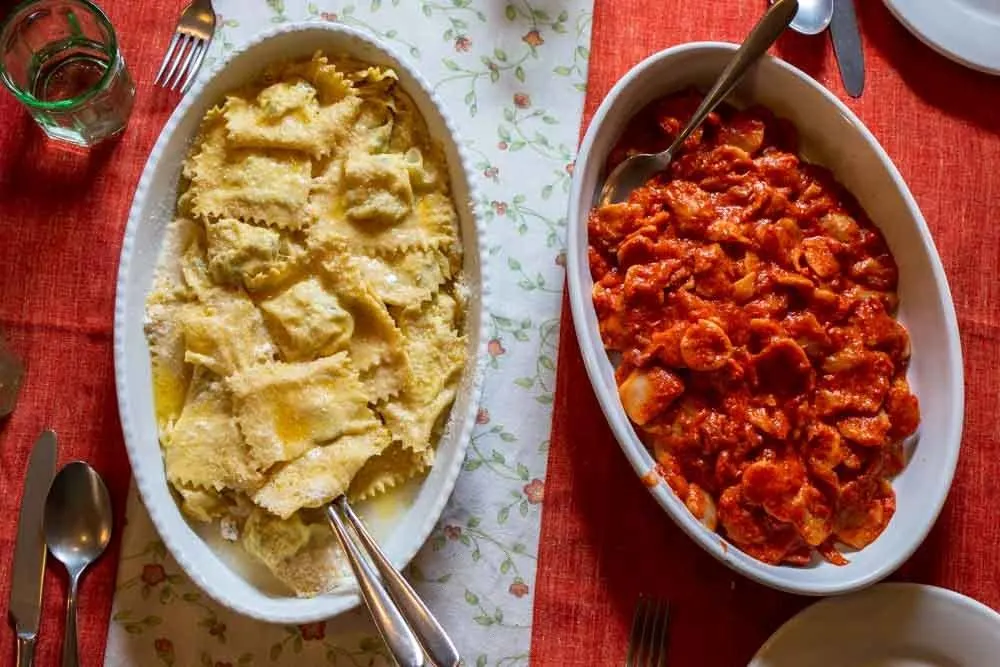
You’ve likely encountered an authentic Italian style menu in the United States. This type of menu features multiple sections including Antipasti (appetizers – soup, salad and small starter plates), Primi (first courses – typically pasta and risotto), Secondi (second courses – usually protein dishes featuring meat and seafood) and Dolci (desserts – often tiramisu and panna cotta).
The urge to order a course from every section of restaurant menus in Italy may be strong. However, it’s entirely possible to enjoy a lunch with two plates of pasta and zero meat courses. At dinner, you may want to order one course from every section of the menu, sharing plates with your dining partner or eating them on your own.
Pro Tip
Get creative and order as much food as you wish, tailoring the experience to your own tastes. At the end of the day, the only person you need to please is yourself.
8. Don’t Rush
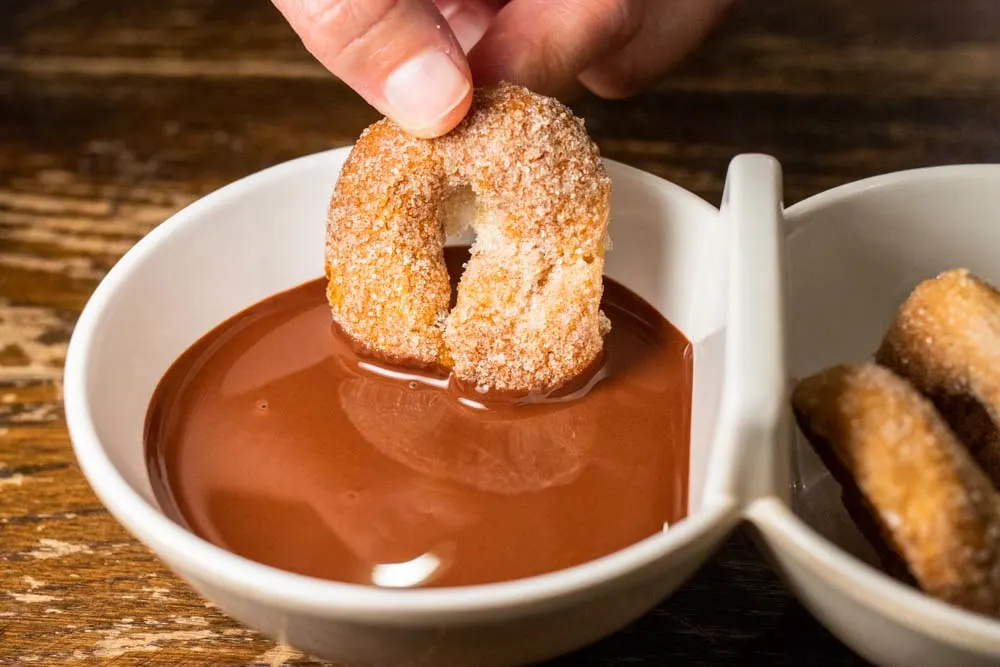
We’ve saved our easiest and most important tip for last…
Don’t rush when you dine in Italy. Instead, savor every bite of every course. Eat that extra piece of bread unless you’re saving it to dip into the bottom of your pasta bowl. And finish your bottle of wine. All of it.
Italian cuisine is unrivaled for both its simplicity and diversity. Pasta dishes and pizza are available all over the world but they’re best enjoyed in Italy. Savor each and every one.
Pro Tip
Focus on creating food memories that you can enjoy for years after your visit.
Check out our picks for the best Italian foods and the best Italian desserts before your trip so that you don’t miss a delicious bite.

About the Authors
Daryl and Mindi Hirsch
Saveur Magazine’s BEST TRAVEL BLOG award winners Daryl and Mindi Hirsch share their culinary travel experiences and recipes on the 2foodtrippers website. Since launching the site in 2012, they’ve traveled to over 40 countries in their quest to bring readers a unique taste of the world.
Original Publication Date: August 29, 2021
